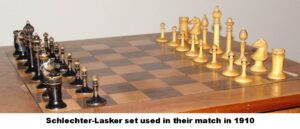The archetype of the "Austrian Upright" is the Schlechter-Lasker (or Lasker-Schlechter!) chess set. The set listed here is almost identical to the one used in the match. It is weighted and may have a slight size deviation.
Original Schlechter-Lasker chess set. Georg Marco, organizer of the Rothschild sponsored Wiener Schachclub, ordered a special chess table with good chessmen from a reputable joinery and turnery which seems to have been named Faludy or Kisfaludy, Hungarian names quite current in Vienna then as now. This is the famous Schlechter-Lasker chess set, which has survived two World Wars and provides the best known specimen of the Austrian Uprights. The set was used in Vienna, where the 1st half of the match was played. The 2nd half was played in Berlin with "Staunton" pieces. The table in the picture could be of that event. Table and set are kept by the Lasker Society in Berlin.
There exist several derivatives of the "Lasker-Schlechter" set. The set below is a nice example. It is not known where these sets were made. Some say Russia referring to the USSR period. Others say Czechia or Hungary. However, the original set was made in Vienna by a joinery of Hungarian turners. Also Nicholas Lanier says that these sets originate in Austria - not the minimal Austria of today, but the larger Austria of the days of the Habsburg Empire!
